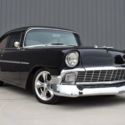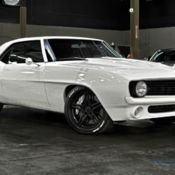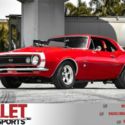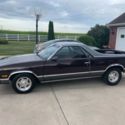1970 Chevy Camaro SS 427Ci/ T56 / Frame Off / Fully Built / +300K Invested
- Price:
- Condition: Used
- Make: Chevrolet
- Model: Camaro
- SubModel: SS
- Type: Coupe
- Doors: 2
- Year: 1970
- Mileage: 1,100
- Color: Gray
- Engine size: 427 V8
- Power options: Air conditioning, Power locks, Power windows
- Transmission: Manual
- Interior color: Black
- Options: Leather seats, CD player
- Vehicle Title: Clear
- Location: Scottsdale, Arizona, United States
Description
The Ultimate build, where does it begin, where does it end and how do you know it's complete? The answer is the car pictured on this page. This is a 1970 Camaro SS with much more than a stellar paint job and some expensive wheels. This isn't just a resto-mod car with an insane price tag. This is the ultimate car. End of story. It's impossible to justify the cost of this car on paper, and even at first glance, this car looks relatively ordinary. So please, take a closer look, and the longer you look, the more you'll begin to understand and fall in love with the immaculate details that exist on every square inch of this automobile.
This 1970 Camaro really begins to make sense the second you open the Anvil hood. When your eyes first glance on the 427 that sits in the engine bay, the numbers, and the magic won't even compute, you will experience sensory overload. After the overwhelming amount of detail hits you and you're finally able to focus in on the details, things will begin to add up in your head. The 8 fuel injected Ream ITB's sticking straight out of the motor. The details continue to pile up the more and more you peak around the engine bay, every single bolt has been replaced and almost every nut and bolt on the entirety of the car came from ARP. It has a bolt-in billet firewall for that matter. Everything has been done to utter perfection in any place you look on the car. Never will you be able to peak underneath a panel or trim piece and say to yourself "oh, really?" Not a single thing on this car looks untouched or out of place.
So you've inspected the engine bay, and it's some big powerful v8 with fancy ITB's, but still, how could someone spend this much money on this car? Inside. That's where the details really begin to sink in. Everything has not only been touched, but also updated. This car has been brought to 2016 in the grandest of fashions. The hand formed metal dash, the billet instrument panel, and the billet gauge surrounds, all of which fit immaculately. Nestling so subtly inside the billet dash are AC vents, which are made from the exact same butterfly valves located inside the Ream ITB's. There was nothing left untouched when this car was built. This car wasn't just a dream brought to reality; it was a prophecy that left no detail unimagined. This car isn't as much a build or someone's nightmare to inherit, this car is perfection beyond what any engineer in a factory could ever procure.
So you've poured over the impressive interior, examined the exceptional engine bay, and it is time to put all of the visual pieces together. The moment the engine fires up, inspiration and excellence fill the air. Turning this 427 over is something no car enthusiast could ever faintly shrug off. The first bark the exhaust announces feels different than any other car. It has a low grumble that is subtle like tasting notes of a fine wine. This experience is a sublime one, not meant to jar neighbors awake, as if announcing in some machismo fashion the excellence that resides within your very garage. No, rather, this car is tuned in every facet, only to pique the interest of a passerby. However, the driver realizes a much different experience than any onlooker. The subtle idle opens to a raucous symphony that follows once the pedal is pushed down. The experience then becomes real, tangible, and austere. The exhaust barks throatily and ignites a primal instinct inside the commander of this craft. The power becomes alive; it is personified as it echoes off passing buildings as the raw speed of this Detroit machine comes to life. Innocent bystanders will immediately experience a surging heartbeat as the aural symphony explodes out the tail pipe. Then, the price tag, however irrelevant at this moment, begins to make sense. This is a toy you didn't know you needed. Now that this has been realized though, it finally makes sense. Again, this is not a fine muscle car; this is a fine driving car. It not only has the raw power and torque America has become famous for, it has an exquisite elegance about it too. Like a line backer in ballet, there is a grace and composure this car has been ascribed. Detroit speed engineering, pretty much had their way with the chassis and this car is track ready. It will thrill any automotive enthusiast with the way that it carves corners around any private circuit in the country. Once behind the wheel, this becomes an emotive driving experience, the kind you expect behind the wheel of any exotic car, but not this. It is a visceral driving experience unlike any other car, while rehashing the glory days of Detroit. As has been said before, this car was brought into 2016 using only the finest parts on the market. The way this car handles the road and track, it rivals anything being produced by anybody today.
This isn't a car you can see online and understand, this isn't a car you can walk by on a showroom floor and comprehend. This car is an experience, it is an event, and it is die-hard love, crafted from the hands of an automotive virtuoso who absolutely encapsulated everything a car should be: into the skin of a 1970 Chevrolet Camaro. It is glory, unimaginably perfected, only understood at the hands of experience. This car is everything you never knew you needed. Seldom few will ever understand it's perfection, but it's essence is exactly that.
By The Numbers
1970 Chevy Camaro
Engine
Type: 427ci big-block Chevy
Block: Chevrolet Performance cast-iron Bore x stroke: 4.250 x 3.760 inches
Rotating assembly: Mach Development, Scat forged crankshaft, Carrillo rods, JE forged pistons, Total Seal rings
Compression ratio: 10.0:1
Cylinder heads: port-matched Dart 310cc rectangle port, cast aluminum
Camshaft: COMP Cams solid roller, .653-/.660-inch lift, 248/254 degrees duration at 050-inch lift, 110-degree LSA
Valvetrain: Manley 2.25-inch intake and 1.88-inch exhaust valves, T&D shaft rockers, Milodon gear drive
Induction: Imagine individual runner (IR) fuel injection by Bob Ream
Throttle body: Imagine EFI, eight port
Engine management: FAST, EZ-EFI
Fuel system: Aeromotive Stealth pump, FAST injectors
Exhaust: custom headers by Pryde Fabrication (1-inch long-tube), dual 3-inch Black ceramic coated exhaust with X-pipe and Borla mufflers
Ignition:MSD Digital 6, MSD HVC II coil, MSD wires
Cooling: Ron Davis custom aluminum radiator, DSE water pump
Other: custom breather vent tanks built by Pryde Fabrication
Output: 655 hp at 6,000 rpm, 633 lb-ft at 5,000 rpm
Engine built by: Bud Yancer
Drivetrain
Transmission: Tremec T56 Magnum six-speed manual with McLeod Racing twin-disc clutch, Billet Joe's shifter
Rearend: narrowed Detroit Speed & Engineering (DSE) 9-inch with Truetrac diff and 3.89 gears
Chassis
Frame: factory unibody construction, modified by Heath Elmer Restorations with rollcage using 1-inch tubing
Front suspension: DSE front subframe with JRi coilover shocks, C6 spindles, splined sway bar, rollcage tied to subframe with 1-inch rollbar tubing, subframes connected with DSE subframe connectors and integrated into floorpan.
Rear suspension: DSE QuadraLink triangulated four-link rear with JRi coilover shocks, DSE splined sway bar, DSE mini-tub kit, DSE subframe connectors
Steering: DSE rack-and-pinion, DSE Delphi 600 pump
Brakes: Baer 6P four-wheel disc brakes all around
Wheels & Tires
Wheels: Rushforth satin black powdercoated Whiplash wheels, 1810 (front) and 1812 (rear)
Tires: BFGoodrich KDW, 275/35R18 (front) and 335/30R18 (rear)
Trades Are Welcome!!
 1967 CHEVY CAMARO RS/SS 383, Over 80K Invested, Frame up Restoration / Retro Mod
1967 CHEVY CAMARO RS/SS 383, Over 80K Invested, Frame up Restoration / Retro Mod
Mileage: 300
 1970 Chevy K5 Blazer Fuel Injected, Turbo charged $80,000 invested Frame off CST
1970 Chevy K5 Blazer Fuel Injected, Turbo charged $80,000 invested Frame off CST
Mileage: 100
 1956 Chevrolet Bel Air/150/210 - Resto-Mod 540 hp LS, Nearly $300K invested!
1956 Chevrolet Bel Air/150/210 - Resto-Mod 540 hp LS, Nearly $300K invested!
Mileage: 9400
 Custom Built Pro-Touring 1969 Camaro Z28 $300k+ Build Cost! SUPER Custom!
Custom Built Pro-Touring 1969 Camaro Z28 $300k+ Build Cost! SUPER Custom!
Mileage: 1,757
 1970 Chevelle SS Show Car with a 468 BB and built right over 55k invested
1970 Chevelle SS Show Car with a 468 BB and built right over 55k invested
Mileage: 78,000
 1967 Supercharged Chevrolet Camaro, Built 355ci, $85k+ Invested in the Build !
1967 Supercharged Chevrolet Camaro, Built 355ci, $85k+ Invested in the Build !
Mileage: 995
 1970 CHEVY C-10 CUSTOM, FRAME OFF REST0, BUILT LS2, WILLWOOD, GORGEOUS
1970 CHEVY C-10 CUSTOM, FRAME OFF REST0, BUILT LS2, WILLWOOD, GORGEOUS
Mileage: 4,579
 1970 Z28/Super Sport Camaro 427ci BBC **One of a Kind**
1970 Z28/Super Sport Camaro 427ci BBC **One of a Kind**
Mileage: 29653
 1987 Chevy el Camino - fully restored, just needs paint! $27,000 invested
1987 Chevy el Camino - fully restored, just needs paint! $27,000 invested
Mileage: 20000
 1970 fully restored Chevy Camaro - Sweet Ride!
1970 fully restored Chevy Camaro - Sweet Ride!
Mileage: 18,000











